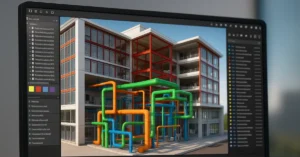Discover Brutalist Buildings in London
London is a city of architectural contrasts, where historic landmarks sit alongside bold modernist structures. Among these, Brutalist architecture has carved out a distinctive presence with its raw concrete surfaces, geometric designs, and imposing forms. Often divisive, these buildings reflect the post-war drive for urban renewal and functionalism. Whether admired or criticized, they remain essential to London’s architectural heritage. In this guide, we explore the most remarkable Brutalist buildings in London and their significance.
What is Brutalist Architecture?
Brutalism, emerging in the mid-20th century, is characterized by the extensive use of raw concrete (“béton brut”), modular design, and a focus on function over ornamentation. Initially popular for civic and residential projects, Brutalism has since become an iconic, if controversial, architectural style in London.
London’s Must-See Brutalist Buildings
1. Barbican Estate
Location: Silk St, London EC2Y 8DS
Architects: Chamberlin, Powell & Bon
Year: 1965–1976
The Barbican Estate is one of the world’s most famous Brutalist developments. Built as a response to post-war housing needs, it consists of residential towers, cultural venues, and gardens. Its striking concrete facades, elevated walkways, and bold geometric design make it a must-visit for Brutalism enthusiasts.
2. National Theatre
Location: Upper Ground, London SE1 9PX
Architect: Denys Lasdun
Year: 1976
Overlooking the River Thames, the National Theatre is one of London’s most striking Brutalist structures. Its layered concrete terraces and dramatic angular design create an unmistakable visual identity. While often polarizing, it remains a key cultural and architectural landmark.
3. Trellick Tower
Location: Golborne Rd, London W10 5PA
Architect: Ernő Goldfinger
Year: 1972
Trellick Tower is a Brutalist high-rise known for its raw concrete exterior and functionalist approach. Designed as social housing, it has since gained iconic status, attracting design enthusiasts and residents who appreciate its distinctive aesthetic and historical significance.
4. Balfron Tower
Location: St Leonard’s Rd, London E14 0QT
Architect: Ernő Goldfinger
Year: 1967
The precursor to Trellick Tower, Balfron Tower embodies similar Brutalist principles with its imposing concrete form and external access corridors. Goldfinger famously lived here to experience the design firsthand, ensuring its functionality and livability.
5. Alexandra Road Estate
Location: Rowley Way, London NW8 0SN
Architect: Neave Brown
Year: 1978
Alexandra Road Estate is one of the most visually striking Brutalist housing projects in London. Its terraced, ziggurat-style apartments and expansive pedestrian spaces showcase a unique take on Brutalist residential design, blending community and functionality.
6. Hayward Gallery
Location: Southbank Centre, Belvedere Rd, London SE1 8XZ
Architects: Higgs and Hill
Year: 1968
Part of the Southbank Centre, the Hayward Gallery exemplifies Brutalism’s sculptural potential. Its raw concrete facades and modular design contribute to its bold visual impact, making it a landmark for art lovers and architecture enthusiasts alike.
7. Royal College of Physicians
Location: 11 St Andrews Pl, London NW1 4LE
Architect: Denys Lasdun
Year: 1964
This lesser-known Brutalist gem blends modernist and classical influences. Featuring exposed concrete, clean lines, and a functional yet elegant design, the Royal College of Physicians is a testament to Lasdun’s architectural vision.
8. Robin Hood Gardens
Location: Poplar, London E14 0UJ
Architects: Alison and Peter Smithson
Year: 1972
Designed as an ambitious social housing project, Robin Hood Gardens embodied the Brutalist vision of community living. Though controversially demolished in recent years, its design philosophy and impact on urban planning remain subjects of discussion.
9. Brunswick Centre
Location: Bernard St, London WC1N 1BS
Architect: Patrick Hodgkinson
Year: 1972
The Brunswick Centre is a mixed-use Brutalist development featuring residential and commercial spaces. Its stepped concrete structure and uniform design create a striking visual identity, making it a key example of Brutalist urban planning.
10. Queen Elizabeth Hall
Location: Southbank Centre, Belvedere Rd, London SE1 8XX
Architects: Hubert Bennett, Jack Whittle, F.G. West
Year: 1967
A major cultural venue, Queen Elizabeth Hall showcases Brutalism’s functionality and bold aesthetics. Its textured concrete and angular design contribute to the Southbank’s unique architectural character.
The Legacy of Brutalism in London
Brutalism in London emerged from a need for durable, cost-effective structures post-World War II. While initially criticized for their stark aesthetics, these buildings have gained recognition as architectural landmarks. Today, many of these structures are being preserved and repurposed, demonstrating the lasting influence of Brutalist design.
Preservation vs. Demolition: The Debate Over Brutalism
Despite growing appreciation for Brutalist architecture, many structures face demolition due to their divisive appearance. Conservationists argue for their historical significance, while developers seek to modernize urban spaces. The future of Brutalism in London remains uncertain, but efforts to protect these buildings continue.
Why You Should Appreciate Brutalism in London
Brutalist buildings in London tell a unique story of resilience, innovation, and bold architectural experimentation. Whether you find them beautiful or austere, these structures are an integral part of the city’s history. Exploring London’s Brutalist landmarks offers insight into an era of urban transformation and the architects who shaped it.
For architecture enthusiasts, a tour of London’s Brutalist buildings is an opportunity to experience the raw power of concrete design. These structures, with their monumental presence and functionalist ethos, stand as bold expressions of an architectural movement that continues to influence contemporary design.
Final Thoughts
Brutalist buildings in London may be divisive, but their impact on the city’s architectural landscape is undeniable. Whether seen as concrete monstrosities or modernist masterpieces, they remain a testament to an era of ambitious urban planning. Next time you walk through London, take a moment to appreciate these bold, raw, and unapologetic structures—they are an essential part of the city’s architectural story.
If you’re interested in learning more about architecture firms in Europe, check out this comprehensive list of the top 50 firms compiled by Archgyan. From innovative startups to long-established industry leaders, this list has it all. Take a look and discover some of the most inspiring and influential architecture firms in Europe today.
If you’re interested in architecture and want to learn more about this amazing field, subscribe to our podcast on youtube
For more SketchUp tutorials, head to https://www.sketchupguru.com










